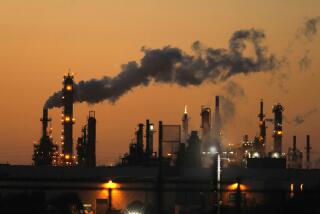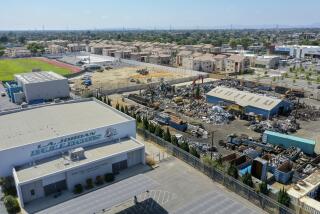U. S. Probes Fatal 1994 Blast at Rockwell
- Share via
Federal agents are investigating whether two Rockwell International Corp. scientists killed in an explosion last year were blowing up toxic waste instead of conducting valid rocket fuel tests, government officials said Friday.
Burning off unneeded rocket fuel chemicals would violate federal environmental laws and breach cleanup contracts that paid Rockwell in excess of $1 million, the officials said.
“They were supposed to dispose of it in accordance with environmental regulations,” one federal investigator said. “By going out in the back yard and disposing of it, you are polluting the environment and causing harm to the government.”
Rockwell scientists Otto K. Heiney and Larry A. Pugh were killed and a third worker was injured on July 26, 1994, when the nitrocellulose and glycidal azide polymer they were handling blew up at the Rocketdyne division’s test lab near Simi Valley.
After the blast, Rockwell officials said the scientists had set up acoustic probes near the open-air test stand in Happy Valley, a rock-lined bowl at the 2,700-acre Santa Susana Field Laboratory, where the firm’s Rocketdyne division develops rocket engines.
The probes, Rocketdyne President Paul Smith said at the time, were used to record shock waves from controlled explosions while the scientists waited in a safe bunker.
But one source close to the case said Friday the blasts were nothing but “bucket tests,” Rockwell slang for tests of no scientific value with only one goal--to get rid of the rocket fuel components.
Rocketdyne spokesman Paul Sewell declined to comment Friday on the subject of the investigation or if the scientists had died while blowing up chemicals to dispose of them.
“It would be impossible to speculate,” he said.
Nor would Sewell confirm whether Rocketdyne had contracts to dispose of the rocket fuel ingredients. Typically under federal contracts, Rockwell would be reimbursed for the cost of disposing of hazardous or toxic materials by the agency that issued the contract that generated the waste.
Thursday, about 40 agents from the FBI, the Environmental Protection Agency, NASA and the U. S. Departments of Defense, Energy, Air Force and Navy raided Rocketdyne’s Santa Susana lab and Canoga Park headquarters, seizing files relating to the explosion.
Over the years, NASA, the Energy Department and military agencies have contracted with Rocketdyne for various research projects at the rugged Santa Susana Field Laboratory, ranging from nuclear reactor testing to the development of space shuttle engines.
“There is a loss to all the agencies if the propellant isn’t disposed of properly,” said an investigator.
The government could be liable for the pollution, he said. Officials said they did not know if burning off the toxic chemicals would create a health risk for nearby communities.
Immediately after last year’s fatal blast, the California Division of Occupational Safety and Health (Cal-OSHA) and Rocketdyne engineers launched investigations.
In January, Cal-OSHA levied $202,500 in fines against Rockwell International for four serious violations of worker safety rules that may have contributed to the explosion. The firm failed to provide enough space or appropriate barriers between work stations or provide sufficient training. It also violated safety standards for testing explosives.
Further, investigators found that Rocketdyne violated state regulations by failing to tell Cal-OSHA where and when the explosives were being made.
Rocketdyne is appealing the citations, said Sewell, the company spokesman.
Rocketdyne’s three-week internal investigation determined that workers were testing the chemicals in the following manner:
Workers filled the bottom of aluminum test pans with a layer of sawdust, a layer of three or four pounds of nitrocellulose and a capping layer of three to four pounds of glycidal azide polymer.
One worker assigned to ignite the mixture inserted an electrical device known as a “match.” He alone carried a key to switch the device on, so the chemicals could not be sparked accidentally while other workers were nearby.
Then, that worker and four colleagues retreated to the safety of a nearby block house and used the key to trigger the match and ignite the chemicals.
Rocketdyne’s investigators concluded that either static, a spark or a hot pan from a previous test ignited about two pounds of highly volatile nitrocellulose in the half-full, open plastic container that one worker was carrying.
Heiney, 53, a Canoga Park engineer, and Pugh, 51, a Thousand Oaks physicist, died instantly, while test mechanic Lee Wells, 62, of Newbury Park, received second- and third-degree burns.
Heiney’s widow, Judith, reached at her home in Shalimar, Fla., said Friday that her attorney has warned her not to comment on the case surrounding her husband’s death. Pugh’s family could not be reached Friday for comment.
Wells, who has since returned to work at Rocketdyne, did not return calls from The Times Friday.
Cal-OSHA turned over the explosion case for criminal prosecution to the Ventura County district attorney’s office in March, said Cal-OSHA spokesman Rick Rice.
County prosecutors determined that Rocketdyne and its employees could face only misdemeanor charges over the handling of volatile chemicals, Deputy Dist. Atty. Donald C. Glynn said.
Instead, Glynn said, he handed the case back to Cal-OSHA in June, telling the agency that federal prosecutors could charge Rocketdyne with violating federal laws that carry much stiffer penalties.
Glynn, Rice and Assistant U. S. Atty. William Carpenter, however, declined to comment on the case.
U. S. Rep. Elton Gallegly (R-Simi Valley) wrote to FBI Director Louis J. Freeh Friday asking to be briefed on the case as soon as possible.
Times staff writer Ralph Vartabedian contributed to this article.
More to Read
Inside the business of entertainment
The Wide Shot brings you news, analysis and insights on everything from streaming wars to production — and what it all means for the future.
You may occasionally receive promotional content from the Los Angeles Times.










